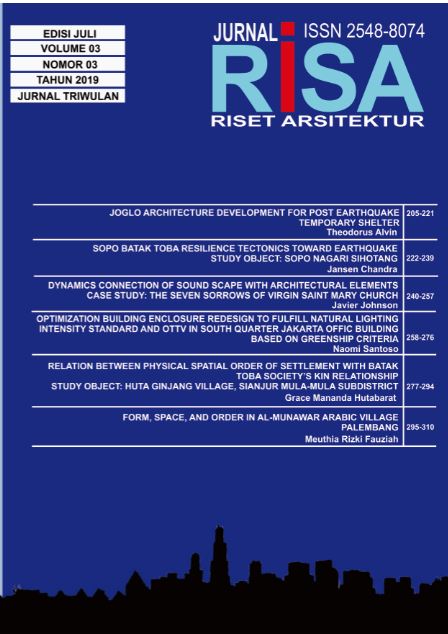JOGLO ARCHITECTURE DEVELOPMENT FOR POST EARTHQUAKE TEMPORARY SHELTER
DOI:
https://doi.org/10.26593/risa.v3i03.3338.205-221Abstract
Abstract- Java Island is one of many islands which has a lot of active volcanoes and also intersected by many active tectonic plates, which cause the locals of the island to be vulnerable and exposed to natural disaster. High population in the island causes the evacuation and post-disaster handling become difficult. One solution to answer the needs of livable housings is temporary shelter. But, many temporary shelters are designed and developed with too many modern features, which caused the shelters to be expensive and hard to be built with participatory methods. Therefore, the idea to adapt Joglo architecture capability of knock-down system as temporary shelter is developed. The research aims to: (1) know the strength and weakness of Joglo architecture as post-earthquake temporary shelter; and (2) develop design prototypes of temporary shelters which adapt Joglo architecture
The methods used in this research is experimental research, which focused on designs that adapt the ability of knock-down in Joglo architecture and later applied in temporary shelters. The data used to support the research are design guidelines and criteria of temporary shelters stated by UNHCR (2011) and the functionality and technical aspects of Joglo architecture composed by Frick (1997). After analyzing the data of Joglo architecture, then the result will be analyzed again with the design criteria of temporary shelters in effectivity and efficiency aspects. The next phase is stating the strengths and weaknesses of Joglo architecture as temporary shelter.
These strengths will be developed, meanwhile the weakness will be handled without diminishing the existing potentials of Joglo architecture as temporary shelter. The final phase is developing 2 types of temporary shelters design prototypes, which have alternatives based on the construction material; coconut wood (type I) and wulung bamboo (type II). These materials are used in order to replace the authentic material of Joglo, teak wood, which is not efficient as temporary shelters structural material. These 2 types of temporary shelters are able to fulfil the design criteria of temporary shelter, because these prototypes are functional (effective) and able to fulfil technical requirements (efficient). Along with this research, the writer hoped that in the future there will be many traditional architectures which will be adapted as a solution to respond the issue of post-disaster architecture.
Key Words: Joglo, knock-down, temporary shelter, post-earthquake












